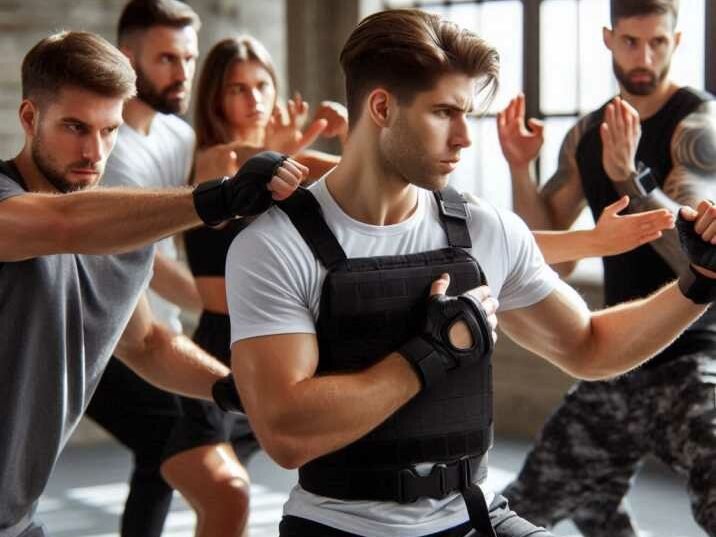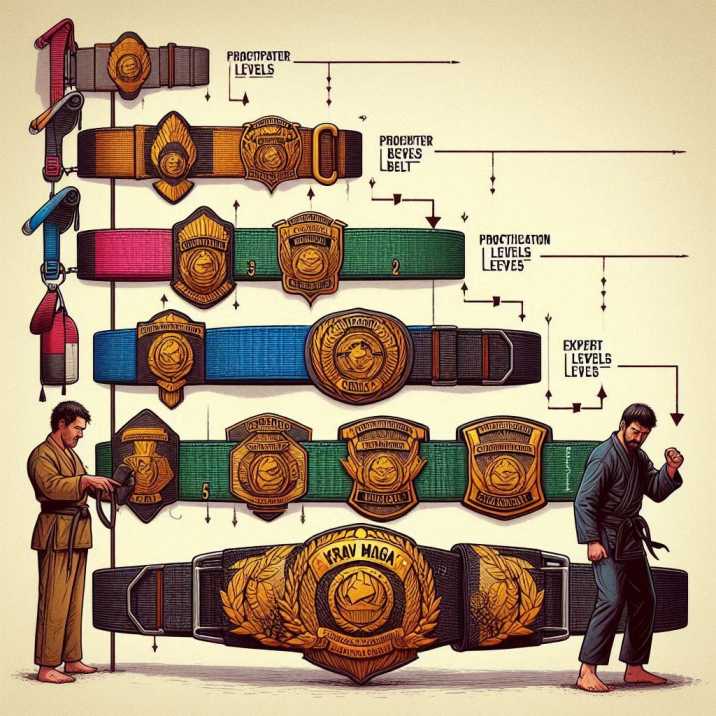Introduction
Table of Contents
Welcome to the ultimate guide to Krav Maga belts! Whether you’re a beginner curious about Krav Maga or an advanced practitioner looking to deepen your understanding, this comprehensive guide will take you through everything you need to know about the Krav Maga ranking system. We’ll delve into the history of Krav Maga, explain the belt system in detail, and provide insights into what each belt represents. By the end of this blog post, you’ll have a clear understanding of Krav Maga belts and what it takes to climb the ranks in this dynamic self-defense system.

Table of Contents
- What is Krav Maga?
- The Origins of Krav Maga
- Key Principles and Techniques
- Understanding the Krav Maga Belt System
- The Purpose of Belts in Martial Arts
- The Evolution of the Krav Maga Belt System
- The Krav Maga Belts Ranks Explained
- Practitioner Levels (P1 to P5)
- Requirements and Skills for Each Level
- Graduate Levels (G1 to G5)
- Requirements and Skills for Each Level
- Expert Levels (E1 to E3)
- Requirements and Skills for Each Level
- Practitioner Levels (P1 to P5)
- The Journey to Black Belt and Beyond
- The Significance of the Black Belt in Krav Maga
- The Road to Becoming an Expert
- Tips for Progressing Through the Ranks
- Training Consistently
- Setting Goals
- Finding a Good Instructor
- Krav Maga Belts: Frequently Asked Questions
- Conclusion
What is Krav Maga?
The Origins of Krav Maga
Krav Maga, which means “contact combat” in Hebrew, is a self-defense system developed for the Israel Defense Forces (IDF) in the 1940s. Its founder, Imi Lichtenfeld, crafted Krav Maga by combining techniques from boxing, wrestling, Judo, and other martial arts with practical street-fighting skills. The primary focus of Krav Maga is real-world situations, emphasizing efficiency and survival.
Key Principles and Techniques
Krav Maga is based on a few core principles:
- Neutralizing Threats: The objective is to completely neutralize the threat as quickly as possible.
- Maintaining Awareness: Practitioners are trained to constantly be aware of their surroundings and potential threats.
- Simultaneous Defense and Attack: Unlike other martial arts where defense and attack are separate actions, Krav Maga often combines them.
- Using Natural Reflexes: Techniques are designed to be simple and use the body’s natural reflexes.
Understanding the Krav Maga Belt System
The Purpose of Belts in Martial Arts
Belts in martial arts serve as a visible indicator of a practitioner’s skill level, experience, and progress. They provide a structured path for learning and mastering techniques and help instructors manage and tailor training sessions according to the students’ abilities.
The Evolution of the Krav Maga Belt System
Initially, Krav Maga did not have a formal belt system. It was only after Krav Maga spread beyond the military and began being taught to civilians that a structured ranking system was introduced. The belt system used in Krav Maga today is similar to that of other martial arts, with different colors representing different levels of proficiency.
The Krav Maga Belts Ranks Explained
Practitioner Levels (P1 to P5)
The Practitioner levels are the foundation of Krav Maga training. They focus on basic techniques, self-defense skills, and building physical fitness.
P1 (Practitioner Level 1)
- Requirements: Basic understanding of Krav Maga principles, commitment to training.
- Skills: Basic strikes (punches, kicks), basic defenses against common attacks, falls and rolls, and basic movement.
P2 (Practitioner Level 2)
- Requirements: Completion of P1, consistent training.
- Skills: Improved striking techniques, defenses against grabs and chokes, basic weapon defenses, and enhanced movement skills.
P3 (Practitioner Level 3)
- Requirements: Completion of P2, demonstrated improvement.
- Skills: Advanced striking combinations, defenses against more complex attacks, ground fighting techniques, and introduction to stress drills.
P4 (Practitioner Level 4)
- Requirements: Completion of P3, proficiency in techniques.
- Skills: Enhanced weapon defenses, multiple attacker scenarios, advanced ground fighting, and tactical training.
P5 (Practitioner Level 5)
- Requirements: Completion of P4, mastery of techniques.
- Skills: Mastery of all basic and advanced techniques, high-level sparring, and preparation for Graduate levels.
Graduate Levels (G1 to G5)
Graduate levels build on the foundation of Practitioner levels and introduce more advanced techniques and scenarios.
G1 (Graduate Level 1)
- Requirements: Completion of P5, commitment to advanced training.
- Skills: Advanced weapon defenses, high-stress scenarios, advanced ground fighting, and tactical training.
G2 (Graduate Level 2)
- Requirements: Completion of G1, demonstrated proficiency.
- Skills: Enhanced striking and defense combinations, advanced weapon scenarios, and tactical decision-making.
G3 (Graduate Level 3)
- Requirements: Completion of G2, high-level skill demonstration.
- Skills: Mastery of Graduate level techniques, multiple attacker scenarios, advanced tactical training, and high-level sparring.
G4 (Graduate Level 4)
- Requirements: Completion of G3, exceptional skill level.
- Skills: Mastery of all advanced techniques, tactical leadership, and preparation for Expert levels.
G5 (Graduate Level 5)
- Requirements: Completion of G4, exemplary skill and leadership.
- Skills: Mastery of all Krav Maga techniques, tactical expertise, and readiness for Expert level testing.
Expert Levels (E1 to E3)
Expert levels signify the highest echelons of Krav Maga proficiency. These levels are typically reserved for instructors and those who have dedicated years to mastering the art.
E1 (Expert Level 1)
- Requirements: Completion of G5, extensive training and experience.
- Skills: Expert-level techniques, tactical leadership, and real-world application.
E2 (Expert Level 2)
- Requirements: Completion of E1, exceptional proficiency.
- Skills: Mastery of all techniques, advanced tactical scenarios, and teaching proficiency.
E3 (Expert Level 3)
- Requirements: Completion of E2, highest level of skill and experience.
- Skills: Mastery of all aspects of Krav Maga, leadership in training, and contribution to the evolution of Krav Maga.

The Journey to Black Belt and Beyond
The Significance of the Black Belt in Krav Maga
In Krav Maga, the black belt represents a high level of proficiency and dedication. It is a significant achievement, indicating that the practitioner has mastered the foundational techniques and is ready to tackle advanced scenarios and challenges.
The Road to Becoming an Expert
Becoming an Expert in Krav Maga requires dedication, consistent training, and a deep understanding of the principles and techniques. It involves not only mastering the physical aspects but also developing the mental and tactical skills necessary for real-world application.
Tips for Progressing Through the Ranks
Training Consistently
Consistency is key in Krav Maga. Regular training helps to build muscle memory, improve fitness, and enhance skills.
Setting Goals
Setting short-term and long-term goals can help keep you motivated and focused. Whether it’s mastering a specific technique or reaching the next belt level, having clear goals can guide your training.
Finding a Good Instructor
A knowledgeable and experienced instructor can make a significant difference in your Krav Maga journey. Look for instructors with a strong background in Krav Maga and a teaching style that suits your learning preferences.
Krav Maga Belts: Frequently Asked Questions
1. How long does it take to earn a black belt in Krav Maga?
The time it takes to earn a black belt can vary, but it typically takes several years of consistent training and dedication.
2. Are there age requirements for Krav Maga belts?
While there are no strict age requirements, most schools have minimum age guidelines for certain belt levels to ensure physical and mental readiness.
3. Can I skip belt levels in Krav Maga?
Skipping belt levels is generally not recommended, as each level builds on the previous one. However, exceptional circumstances may allow for accelerated progression.
4. What should I expect during a Krav Maga belt test?
Belt tests typically involve demonstrating proficiency in techniques, sparring, and handling stress scenarios. The difficulty and requirements increase with each level.
5. Is Krav Maga suitable for children?
Yes, many schools offer Krav Maga programs tailored for children, focusing on self-defense, fitness, and confidence-building.
Conclusion
Krav Maga belts provide a structured path for learning and mastering this practical and dynamic self-defense system. Whether you’re just starting or looking to advance to higher levels, understanding the belt system can help guide your training and set clear goals. Remember, the journey through Krav Maga is as much about personal growth and development as it is about mastering techniques. Stay dedicated, train consistently, and embrace the principles of Krav Maga to progress through the ranks and become a skilled practitioner.


